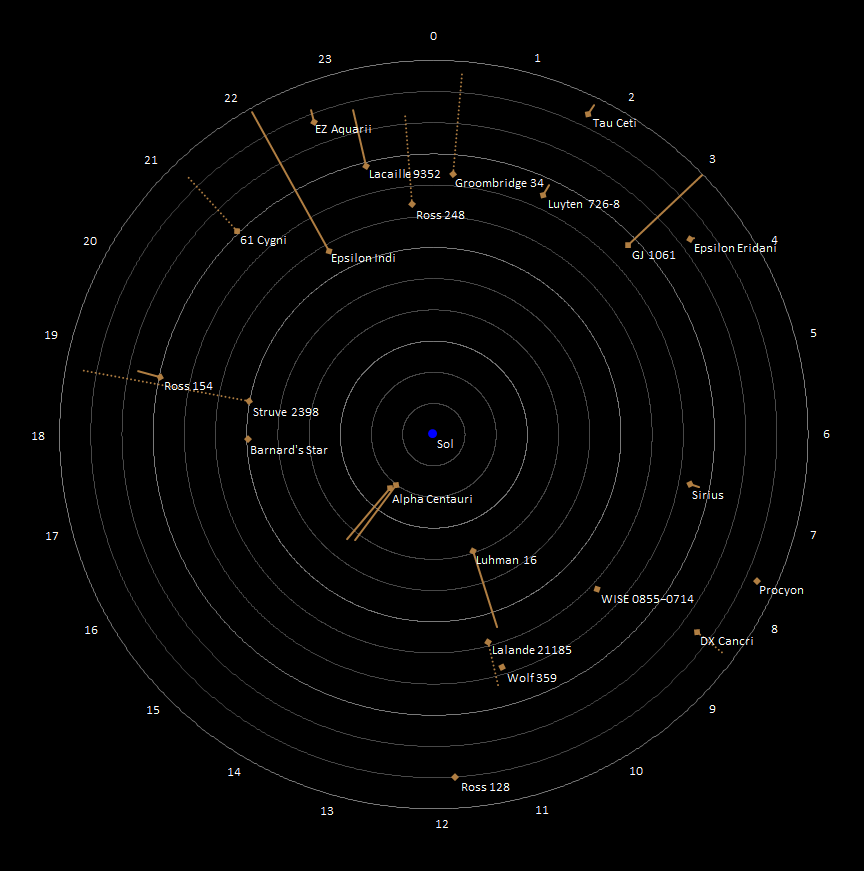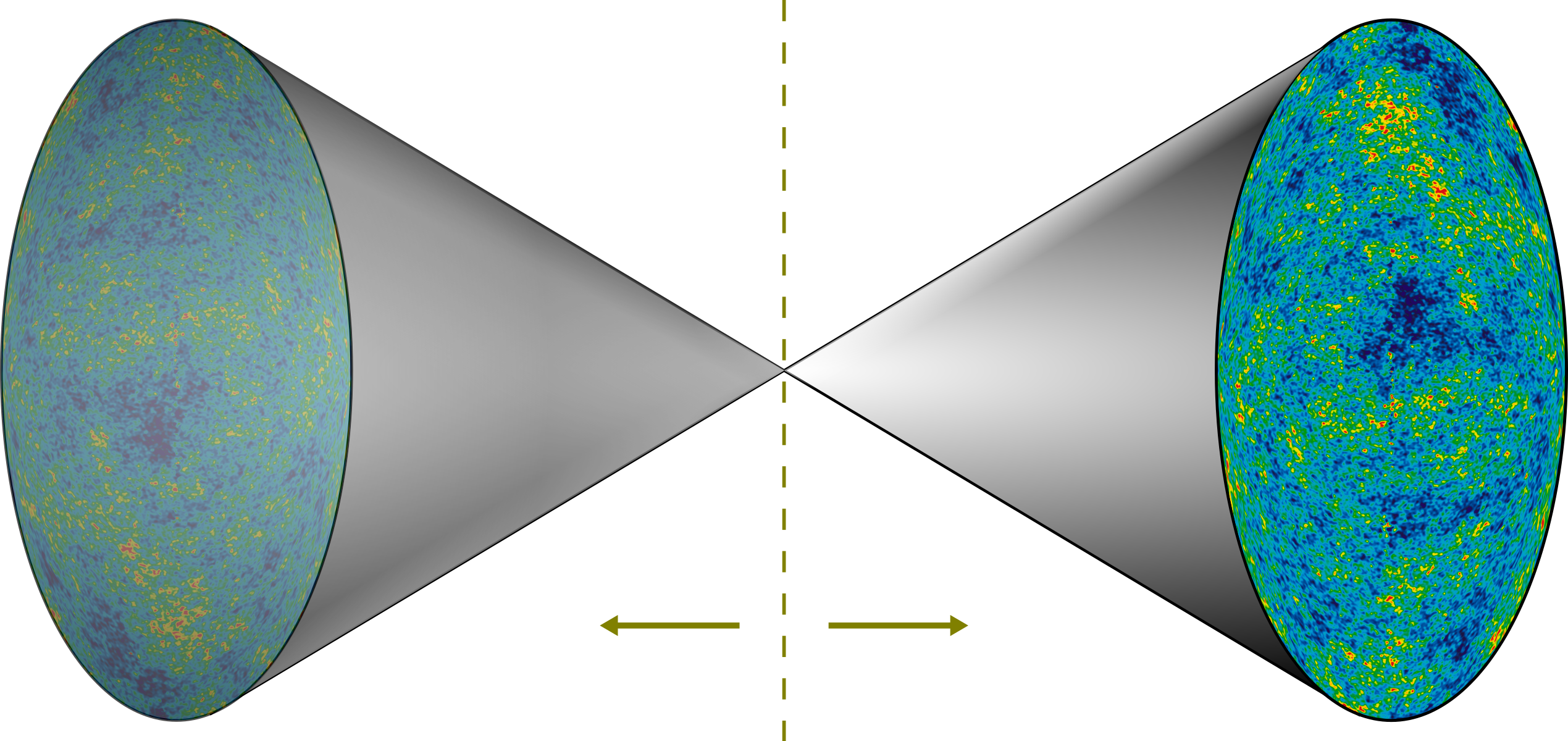|
Earth's Location
Knowledge of the location of Earth has been shaped by 400 years of telescopic observations, and has expanded radically since the start of the 20th century. Initially, Earth was believed to be the center of the Universe, which consisted only of those planets visible with the naked eye and an outlying sphere of fixed stars. After the acceptance of the heliocentric model in the 17th century, observations by William Herschel and others showed that the Sun lay within a vast, disc-shaped galaxy of stars. By the 20th century, observations of spiral nebulae revealed that the Milky Way galaxy was one of billions in an expanding universe, grouped into clusters and superclusters. By the end of the 20th century, the overall structure of the visible universe was becoming clearer, with superclusters forming into a vast web of filaments and voids. Superclusters, filaments and voids are the largest coherent structures in the Universe that we can observe. At still larger scales (over 1000 ... [...More Info...] [...Related Items...] OR: [Wikipedia] [Google] [Baidu] |
Geocentric Model
In astronomy, the geocentric model (also known as geocentrism, often exemplified specifically by the Ptolemaic system) is a superseded description of the Universe with Earth at the center. Under most geocentric models, the Sun, Moon, stars, and planets all orbit Earth. The geocentric model was the predominant description of the cosmos in many European ancient civilizations, such as those of Aristotle in Classical Greece and Ptolemy in Roman Egypt. Two observations supported the idea that Earth was the center of the Universe: * First, from anywhere on Earth, the Sun appears to revolve around Earth once per day. While the Moon and the planets have their own motions, they also appear to revolve around Earth about once per day. The stars appeared to be fixed on a celestial sphere rotating once each day about an axis through the geographic poles of Earth. * Second, Earth seems to be unmoving from the perspective of an earthbound observer; it feels solid, stable, and stationary ... [...More Info...] [...Related Items...] OR: [Wikipedia] [Google] [Baidu] |
Megaparsec
The parsec (symbol: pc) is a unit of length used to measure the large distances to astronomical objects outside the Solar System, approximately equal to or (au), i.e. . The parsec unit is obtained by the use of parallax and trigonometry, and is defined as the distance at which 1 au subtends an angle of one arcsecond ( of a degree). This corresponds to astronomical units, i.e. 1\, \mathrm = 1/\tan \left( \ \mathrm \right)\, \mathrm. The nearest star, Proxima Centauri, is about from the Sun. Most stars visible to the naked eye are within a few hundred parsecs of the Sun, with the most distant at a few thousand. The word ''parsec'' is a portmanteau of "parallax of one second" and was coined by the British astronomer Herbert Hall Turner in 1913 to make calculations of astronomical distances from only raw observational data easy for astronomers. Partly for this reason, it is the unit preferred in astronomy and astrophysics, though the light-year remains prominent in popular ... [...More Info...] [...Related Items...] OR: [Wikipedia] [Google] [Baidu] |
Universe
The universe is all of space and time and their contents, including planets, stars, galaxies, and all other forms of matter and energy. The Big Bang theory is the prevailing cosmological description of the development of the universe. According to this theory, space and time emerged together ago, and the universe has been expanding ever since the Big Bang. While the spatial size of the entire universe is unknown, it is possible to measure the size of the observable universe, which is approximately 93 billion light-years in diameter at the present day. Some of the earliest cosmological models of the universe were developed by ancient Greek and Indian philosophers and were geocentric, placing Earth at the center. Over the centuries, more precise astronomical observations led Nicolaus Copernicus to develop the heliocentric model with the Sun at the center of the Solar System. In developing the law of universal gravitation, Isaac Newton built upon Copernicus's wor ... [...More Info...] [...Related Items...] OR: [Wikipedia] [Google] [Baidu] |
Milky Way Arms Ssc2008-10
Milky is an Italian dance music production group consisting of producers Giordano Trivellato and Giuliano Sacchetto, with Italian singer Giuditta serving as their lead singer on their album ''Star''. Although Giuditta Gazza was the singer on the recordings, a model, the Egyptian-born and German-raised Sabrina Elahl, was used for the music video for the " Just the Way You Are" single. The same model was used for the cover. Elahl's voice did not appear on any of Milky's recordings, where all songs were sung by Giuditta. Giuditta can be seen on the " |
Angular Map Of Fusors Around Sol Within 12ly
Angular may refer to: Anatomy * Angular artery, the terminal part of the facial artery * Angular bone, a large bone in the lower jaw of amphibians and reptiles * Angular incisure, a small anatomical notch on the stomach * Angular gyrus, a region of the brain in the parietal lobe * Angular vein, formed by the junction of the frontal vein and supraorbital vein Other uses * Angular (web framework), an open-source web platform ** AngularJS, the first incarnation of Angular * Angle, having an angle or angles * Angular diameter The angular diameter, angular size, apparent diameter, or apparent size is an angular distance describing how large a sphere or circle appears from a given point of view. In the vision sciences, it is called the visual angle, and in optics, it is ..., describing how large a sphere or circle appears from a given point of view ** Angular diameter distance, used in astronomy * Angular Recording Corporation, a British independent record label See also * Ang ... [...More Info...] [...Related Items...] OR: [Wikipedia] [Google] [Baidu] |
Falsifiable
Falsifiability is a standard of evaluation of scientific theories and hypotheses that was introduced by the philosopher of science Karl Popper in his book ''The Logic of Scientific Discovery'' (1934). He proposed it as the cornerstone of a solution to both the problem of induction and the problem of demarcation. A theory or hypothesis is falsifiable (or refutable) if it can be ''logically'' contradicted by an empirical test that can potentially be executed with existing technologies. Popper insisted that, as a logical criterion, it is distinct from the related concept "capacity to be proven wrong" discussed in Lakatos' falsificationism. Even being a logical criterion, its purpose is to make the theory predictive and testable, thus useful in practice. Popper opposed falsifiability to the intuitively similar concept of verifiability. Verifying the claim "All swans are white" would theoretically require observing all swans, which in actuality, is not possible. In contrast, ... [...More Info...] [...Related Items...] OR: [Wikipedia] [Google] [Baidu] |
Multiverse
The multiverse is a hypothetical group of multiple universes. Together, these universes comprise everything that exists: the entirety of space, time, matter, energy, information, and the physical laws and constants that describe them. The different universes within the multiverse are called "parallel universes", "other universes", "alternate universes", or "many worlds". History of the concept According to some, the idea of infinite worlds was first suggested by the pre-Socratic Greek philosopher Anaximander in the sixth century BCE. However, there is debate as to whether he believed in multiple worlds, and if he did, whether those worlds were co-existent or successive. The first to whom we can definitively attribute the concept of innumerable worlds are the Ancient Greek Atomists, beginning with Leucippus and Democritus in the 5th century BCE, followed by Epicurus (341-270 BCE) and Lucretius (1st century BCE). In the third century BCE, the philosopher Chrysippus su ... [...More Info...] [...Related Items...] OR: [Wikipedia] [Google] [Baidu] |
Infinity
Infinity is that which is boundless, endless, or larger than any natural number. It is often denoted by the infinity symbol . Since the time of the ancient Greeks, the philosophical nature of infinity was the subject of many discussions among philosophers. In the 17th century, with the introduction of the infinity symbol and the infinitesimal calculus, mathematicians began to work with infinite series and what some mathematicians (including l'Hôpital and Bernoulli) regarded as infinitely small quantities, but infinity continued to be associated with endless processes. As mathematicians struggled with the foundation of calculus, it remained unclear whether infinity could be considered as a number or magnitude and, if so, how this could be done. At the end of the 19th century, Georg Cantor enlarged the mathematical study of infinity by studying infinite sets and infinite numbers, showing that they can be of various sizes. For example, if a line is viewed as the set of ... [...More Info...] [...Related Items...] OR: [Wikipedia] [Google] [Baidu] |
Observable Universe
The observable universe is a ball-shaped region of the universe comprising all matter that can be observed from Earth or its space-based telescopes and exploratory probes at the present time, because the electromagnetic radiation from these objects has had time to reach the Solar System and Earth since the beginning of the cosmological expansion. There may be 2 trillion galaxies in the observable universe, although that number was reduced in 2021 to only several hundred billion based on data from '' New Horizons''. Assuming the universe is isotropic, the distance to the edge of the observable universe is roughly the same in every direction. That is, the observable universe is a spherical region centered on the observer and is unique for every unique observational position. The word ''observable'' in this sense does not refer to the capability of modern technology to detect light or other information from an object, or whether there is anything to be detected. It refers to th ... [...More Info...] [...Related Items...] OR: [Wikipedia] [Google] [Baidu] |
Springer Science+Business Media
Springer Science+Business Media, commonly known as Springer, is a German multinational publishing company of books, e-books and peer-reviewed journals in science, humanities, technical and medical (STM) publishing. Originally founded in 1842 in Berlin, it expanded internationally in the 1960s, and through mergers in the 1990s and a sale to venture capitalists it fused with Wolters Kluwer and eventually became part of Springer Nature in 2015. Springer has major offices in Berlin, Heidelberg, Dordrecht, and New York City. History Julius Springer founded Springer-Verlag in Berlin in 1842 and his son Ferdinand Springer grew it from a small firm of 4 employees into Germany's then second largest academic publisher with 65 staff in 1872.Chronology ". Springer Science+Business Media. In 1964, Springer expanded its business internationa ... [...More Info...] [...Related Items...] OR: [Wikipedia] [Google] [Baidu] |
Princeton University Press
Princeton University Press is an independent publisher with close connections to Princeton University. Its mission is to disseminate scholarship within academia and society at large. The press was founded by Whitney Darrow, with the financial support of Charles Scribner, as a printing press to serve the Princeton community in 1905. Its distinctive building was constructed in 1911 on William Street in Princeton. Its first book was a new 1912 edition of John Witherspoon's ''Lectures on Moral Philosophy.'' History Princeton University Press was founded in 1905 by a recent Princeton graduate, Whitney Darrow, with financial support from another Princetonian, Charles Scribner II. Darrow and Scribner purchased the equipment and assumed the operations of two already existing local publishers, that of the ''Princeton Alumni Weekly'' and the Princeton Press. The new press printed both local newspapers, university documents, ''The Daily Princetonian'', and later added book publishing ... [...More Info...] [...Related Items...] OR: [Wikipedia] [Google] [Baidu] |






